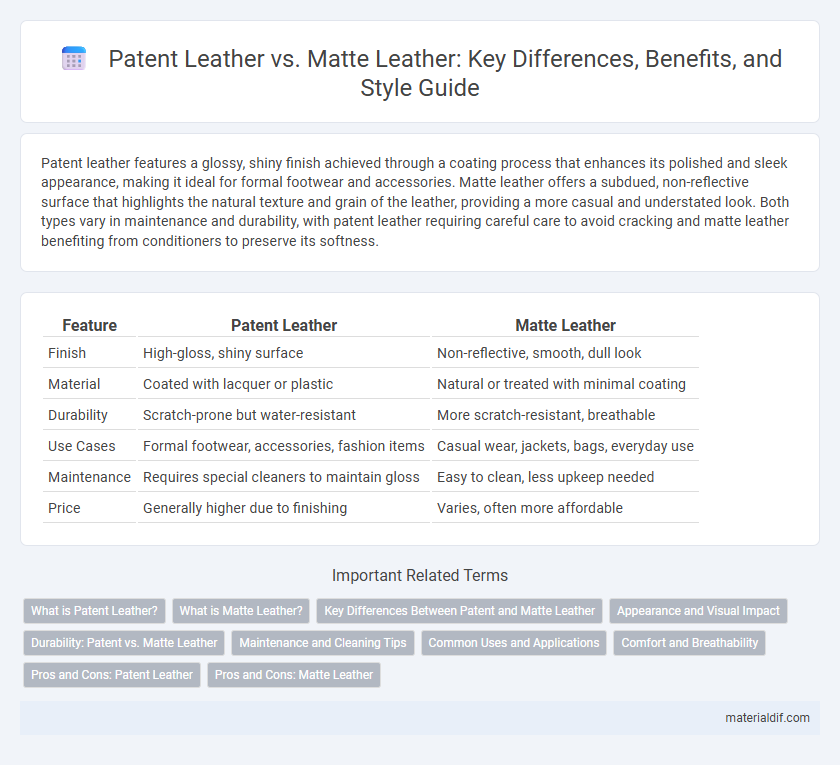Patent leather features a glossy, shiny finish achieved through a coating process that enhances its polished and sleek appearance, making it ideal for formal footwear and accessories. Matte leather offers a subdued, non-reflective surface that highlights the natural texture and grain of the leather, providing a more casual and understated look. Both types vary in maintenance and durability, with patent leather requiring careful care to avoid cracking and matte leather benefiting from conditioners to preserve its softness.
Table of Comparison
| Feature | Patent Leather | Matte Leather |
|---|---|---|
| Finish | High-gloss, shiny surface | Non-reflective, smooth, dull look |
| Material | Coated with lacquer or plastic | Natural or treated with minimal coating |
| Durability | Scratch-prone but water-resistant | More scratch-resistant, breathable |
| Use Cases | Formal footwear, accessories, fashion items | Casual wear, jackets, bags, everyday use |
| Maintenance | Requires special cleaners to maintain gloss | Easy to clean, less upkeep needed |
| Price | Generally higher due to finishing | Varies, often more affordable |
What is Patent Leather?
Patent leather is a type of coated leather distinguished by its glossy, high-shine finish achieved through a varnish or lacquer coating. It offers a sleek, polished appearance that enhances durability and water resistance compared to matte leather, which features a natural, non-reflective surface. Commonly used in formal shoes, handbags, and accessories, patent leather requires careful maintenance to preserve its signature sheen and prevent cracking.
What is Matte Leather?
Matte leather features a non-reflective, smooth surface created by minimizing the wax or polish that gives patent leather its glossy finish. Unlike patent leather, which is coated with a shiny lacquer for a mirror-like appearance, matte leather retains a natural, understated texture that emphasizes the material's organic grain. This type of leather is prized for its subtle elegance, durability, and versatility in fashion and upholstery.
Key Differences Between Patent and Matte Leather
Patent leather features a glossy, reflective finish achieved through a coating process, while matte leather has a natural, non-reflective surface that emphasizes texture. Patent leather is more resistant to water and stains but can be prone to cracking over time, whereas matte leather offers better breathability and develops a rich patina with use. Maintenance for patent leather typically involves gentle wiping to preserve shine, whereas matte leather requires conditioning to prevent drying and maintain softness.
Appearance and Visual Impact
Patent leather showcases a high-gloss, mirror-like finish that instantly captures light, creating a sleek and polished appearance ideal for formal wear and statement pieces. Matte leather features a soft, non-reflective surface with a muted, natural texture that conveys understated elegance and versatility for everyday use. The visual impact of patent leather is bold and attention-grabbing, while matte leather offers subtle sophistication and timeless appeal.
Durability: Patent vs. Matte Leather
Patent leather, coated with a glossy varnish, offers enhanced resistance to water and stains, making it more durable in wet conditions compared to matte leather. Matte leather, prized for its natural texture and breathability, can develop scratches and scuff marks more easily, requiring regular conditioning to maintain its durability. Both leather types benefit from proper care, but patent leather's protective finish generally extends its lifespan in exposure-prone environments.
Maintenance and Cleaning Tips
Patent leather requires gentle cleaning with a soft, damp cloth and mild soap to maintain its glossy finish, avoiding abrasive materials that can cause scratches. Matte leather benefits from regular brushing with a soft-bristled brush to remove dirt, followed by conditioning with a matte-specific leather moisturizer to prevent drying and cracking. Both leather types should be kept away from direct sunlight and excessive moisture to preserve texture and durability.
Common Uses and Applications
Patent leather, known for its glossy, reflective finish, is commonly used in formal footwear, luxury handbags, and dress accessories, where its polished appearance enhances elegance. Matte leather, with its subdued, non-reflective surface, is favored in casual footwear, jackets, and furniture upholstery for a sophisticated yet understated look. Both leathers serve distinct fashion and design purposes, catering to varying style preferences and functional demands.
Comfort and Breathability
Patent leather features a glossy, non-porous surface that limits airflow, often resulting in reduced breathability and less comfort during extended wear. Matte leather, with its natural texture and porous finish, provides better ventilation, enhancing comfort by allowing moisture and heat to escape. For applications prioritizing comfort and breathability, matte leather remains the superior choice over patent leather.
Pros and Cons: Patent Leather
Patent leather offers a glossy, high-shine finish that enhances the appearance of formal footwear and accessories, making it highly resistant to water and stains. However, its surface is prone to scuffing and cracking over time, reducing durability compared to other leather types. This type of leather requires careful maintenance to preserve its reflective qualities and avoid damage from heat or excessive bending.
Pros and Cons: Matte Leather
Matte leather offers a sophisticated, understated appearance that resists fingerprints and scratches better than glossy finishes, making it ideal for everyday use and minimal maintenance. It tends to age gracefully, developing a unique patina that enhances its character over time but can absorb stains more readily due to its porous surface. Matte leather is generally less reflective, providing a versatile and timeless aesthetic, yet it may require specialized cleaning products to preserve its texture and prevent drying.
Patent leather vs Matte leather Infographic

 materialdif.com
materialdif.com